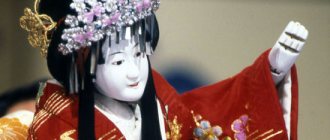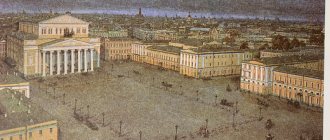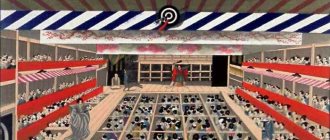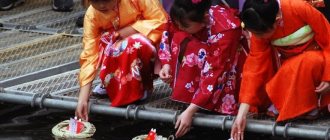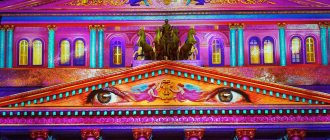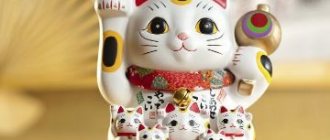The history of bunraku
Initially there were no dolls. The role of storytellers was played by artists and musicians traveling around Japan. They composed ballads about the royal family, brave wars, love and other eternal themes. Chants to the sounds of the shamisen (a three-stringed musical instrument somewhat reminiscent of a balalaika) were wildly popular, regularly attracting full houses.
Puppet shows began after there was a need to somehow diversify the stories and involve the audience in the narrative. This happened in the 17th century. And the name “bunraku” appeared only in 1805, when a man named Uemura Banrakuken purchased one of the theaters and decided to give it his name. After some time, “bunraku” became a household name. Now this is what all Japanese puppet theaters are called.
The dolls themselves deserve special attention. They were controlled using strings, and often two or three actors were responsible for the movements of one doll. This was done to “revive” the characters.
The figures were most often made from wood, after which the artists got to work and applied varnish. The costumes were also thought out to the smallest detail, as a result of which a good doll cost a lot of money and was treated with great care.
Evolution of Bunraku: a barrier-free environment
Puppeteers talk about the art of Bunraku
For the performances, two short plays are prepared related to the place of performances, which would be understandable even to those spectators who are in Bunraku for the first time. The special performance at Ise-jingu Shrine is also an offering to the gods, so the festive play “Two Sambaso Dancers” (Ninin Sambaso) was chosen for the performance, performed since the Edo period, when the gods were asked to send down a rich harvest. The second play of the show is “Yoshitsune’s Thousand Cherry Blossoms” (Yoshitsune Sembonzakura), where the action takes place in Yoshino, where the cypress tree from which the theater is built was taken. In addition, many people with special needs are invited to this performance and will be provided with audio guides, Braille explanations, and tablets with subtitles. The performance can also be seen by people in wheelchairs, and those accompanying them can also go with them. This will be the first barrier-free performance in Bunraku's history. During the break between plays, tayu storytellers, shamisen musicians and puppeteers will tell about the Bunraku theater in simple words, so that children can understand it.
The play “Two Sambaso Dancers” (Ninin Sambaso) was also performed during the first performance of “Nippon Bunraku” at Roppongi Hills.
The project is planned to continue until the Olympic and Paralympic Games in Tokyo in 2021. Plans are being considered to show Bunraku in Paris in order to show this art to as many people as possible, not only in Japan. Nakamura Masayuki, director of the Noh Theater in Yokohama, who is serving as the project's producer, says: “The previous three performances were attended by a lot of people, but when we walked in procession along Nakamise Street in Asakusa, many of the tourists we met along the way asked what these are the dolls, and it was painful to realize how little people knew about Bunraku. In order for as many people as possible to know about it, in the “Nippon Bunraku” project we will make barrier-free performances, travel abroad and make every effort to do this. If you have the opportunity, be sure to come and see!”
Nippon Bunraku performances always attract large audiences
Nippon Bunraku performances at Ise-jingu Shrine
- Time: 11 to 14 March 2021, two performances daily, afternoon and evening
- Tickets: free; Reservations required via website (see below)
- Location: Special stage near Geku (Outer Shrine)
- Official website (in Japanese)
Banner photo: Nippon Bunraku performance at Sensoji Temple in Asakusa
Photos by Miwa Noriaki (unless otherwise noted).
This article was written in collaboration with Nippon Bunraku. (Article in Japanese published February 6, 2021)
Participants of the play
To organize a bunraku puppet show, you need:
- Actors who will control the doll (most often - three for each character).
- A reader narrating a story.
- Musicians who set the mood for the performance.
Only at first glance, it seems as if it is easy to control the doll. In fact, getting three people to work well together is a process that requires a huge amount of time and effort.
The legs are controlled by Ashi-zukai, the youngest of the puppeteers, but he, too, is forced to study for 10 (yes, you heard that right) years before appearing on stage.
But the most difficult thing, of course, is the head. Puppets in Japanese theaters have flexible facial expressions and, with the help of a puppeteer, can express any emotion. Omi-zukai is the name given to the person responsible for the doll's head. It takes 30 years to get such a position (training + work in secondary roles).
Gidayu - reader
Surprisingly, if each doll is controlled by three people, then there is only one narrator (gidayu). This person voices all the characters, and is often also responsible for additional sounds (imitation of nature, gunshots, etc.). If he fails to cope with his duties, it will be quite difficult to follow what is happening on stage.
The most difficult thing about working as a gidayu is to match the movements of the puppets’ lips with your lines. At the same time, it is important to understand that he, like all the other actors, is on stage in front of the audience. Japanese puppet theaters do not have partitions behind which the workers hide, and a curtain is needed only to indicate the beginning/end of the performance. Yes, the Gidayu and their colleagues are dressed in black kimonos so as not to draw attention to themselves, but being on stage still creates additional difficulties.
Traditional puppet theater Bunraku
Greetings, residents of baby towns! Happy World Puppet and Puppet Theater Day to everyone! Today I want to talk about the Bunraku theater - a traditional Japanese puppet theater. Bunraku is widely known outside of Japan, and is even included by UNESCO in the list of sites subject to protection in accordance with the Convention for the Protection of the Intangible Cultural Heritage. Traditional Japanese puppet theater originated in the early 17th century, just like traditional kabuki theater, which I mentioned in a previous post. Like kabuki, puppet theater was a fusion of dramatic and musical art: the central characters were puppets (ningyo), performances were accompanied by shamisen (a national three-stringed plucked instrument, analogous to a lute) and were accompanied by traditional joruri recitative. This performance was called ningyo joruri. The word bunraku appeared much later, at the beginning of the nineteenth century. This was the name of one of the theaters in Osaka, named after Uemura Bunrakuken (1751–1810), a famous director of ningyo joruri performances.
Bunraku performance, 19th century.
Ningyo joruri performances gained great popularity at the beginning of the eighteenth century thanks to the tandem of playwright Chikamatsu Monzaemon (1653-1725) and joruri performer Takemoto Gidayu (1651-1714). Chikamatsu wrote dozens of plays specifically for Ningyo Joruri, many of which were later adapted for the Kabuki theater. One of them, “The Suicide of Lovers in Sonezaki” (1703), which tells the story of the tragic love between the young assistant of the merchant Tokubei and yujo O-Hatsu, was so popular that it caused a wave of real double suicides.
Bronze sculpture of the characters from Sonezaki's Lovers' Suicide.
By the mid-eighteenth century, the style of theatrical performance now known as bunraku had finally emerged. Bunraku dolls, about 120 cm tall, are a complex structure consisting of a wooden head, a pair of arms (often with articulated fingers) and a pair of legs (for male characters only), connected together by a complex system of threads.
Blank for a doll's head.
Bunraku doll without clothes.
Costumes for theatrical puppets are made by craftsmen with exactly the same attention and skill as costumes for live actors. The clothes are decorated with various colors and patterns. Typically, the costume includes a collar underneath, a belt, a kimono, and a haori (jacket).
A doll may have a complex mechanism in its head. For example, in plays with supernatural themes, the doll's head may be designed so that its face can suddenly change during the action, for example, into the physiognomy of a demon. A less complex example of a doll's head mechanism is eyes that move up and down, side to side, or moving noses, mouths, and eyebrows.
The main characters of bunraku. In the bottom row in the middle is a kitsune, a werefox.
Transformation of Gabu, a girl - a demon.
The doll is controlled by three puppeteers: the main puppeteer (omo-zukai) controls the head and right hand, the second (hidari-zukai) controls the left hand, and the third (ashi-zukai) controls the movement of the doll’s legs (or controls the folds of clothing that imitate the movement of the legs). Guided by the instructions of the main puppeteer, the other two synchronize their movements with him, controlling the movements of the doll. It takes decades to master the art of controlling a bunraku doll, which is typical for any traditional Japanese art. It takes at least ten years to learn how to control the doll’s legs, then at least another ten years as a “left hand.” And only after this the puppeteer is trusted to control the heads of minor characters. Only the most experienced and mature masters can control the heads of the central characters. For this reason, when performing on stage, most often the face of the main puppeteer is open, while the rest have dark hoods on their heads that cover their faces. The shape of a puppeteer's hood varies depending on the school to which he belongs.
In terms of performance text, usually one person, the gidayu, delivers all of the characters' lines, varying the voice, vocal delivery, and style to portray the different characters. Gidayu sits to the right of the stage next to the man who plays the shamisen.
Today, the predominant venue for bunraku puppet shows is the National Bunraku Theater in Osaka, but troupes also perform in Tokyo and regional theaters. Bunraku troupes also actively tour around the world. The repertoire includes both modern plays and canonical works from the Edo period (1603–1868), which, however, have been reduced from the original six acts to two or three.
Thank you for your attention! And once again, happy puppeteer day to all of us!
When preparing the publication, I used materials from the sites: *** medium.com/@veiled.valentina/%D1%82%D0%B5%D0%B0%D1%82%D1%80-%D0%B1%D1%83%D0 %BD%D1%80%D0%B0%D0%BA%D1%83-8d8be9b46de*** *** www.nippon.com/ru/column/g00219/?pnum=1*** *** vk. com/@alice_evans96-bunraku-tradicionnyi-kukolnyi-teatr-yaponii*** *** www.japan-zone.com/culture/bunraku.shtml*** *** www.britannica.com/art/Bunraku** * ***traditionalkyoto.com/culture/bunraku/***
PS When preparing this publication, I did not find any viruses on any of the Internet resources. I am not so selfless as to engage in educational activities by visiting sites with an unfavorable epidemiological situation.
Bunraku today
The Japanese bunraku puppet theater continues to be popular even after the advent of cinema and other forms of entertainment. Except that performances now take place in regular theaters. The troupes of some theaters continue to tour and even travel abroad, but they do this only a few times a year.
It is possible to see bunraku performances in our country, but very rarely and only in large cities. Thus, if you want to visit a Japanese puppet theater, the easiest way to do this is during a trip to the Land of the Rising Sun.
The largest bunraku theater is located in the city of Osaka - this is the same institution that Uemura Banrakuken bought more than two hundred years ago.
<Japanese rickshaws Shodo - the art of Japanese calligraphy>
Back to basics: theater as entertainment
A distinctive feature of the project is that spectators are located in the open air and can eat and drink. In the Edo era, when Bunraku theater appeared, it was an entertainment art. The performances took place on temporary platforms built in temples and shrines, or on the banks of the river, and people were entertained, eating, drinking and watching the performance in a relaxed atmosphere. Now, when plays are performed in national theaters, Bunraku has begun to be perceived more as a high traditional art, which is difficult for the average person to understand.
At a press conference on the occasion of the launch of the Nippon Bunraku project, puppeteer Kiritake Kanjuro III, analyzing the reasons for the decline in popularity of Bunraku, said: “The skill of the art of Bunraku has been passed on and honed over the years. The flip side of this is that it is no longer accessible to the public, and this has led to fewer people being able to experience it as entertainment.” Based on this opinion and the history of the theater, the Nippon Bunraku project was created, with the goal of reviving Bunraku as an entertainment art and showing its beauty to a wide audience.
Kiritake Kanjuro III during a press showcase at the Hills Cafe in August 2014 (photo by Osawa Hisayoshi)
